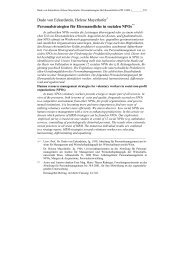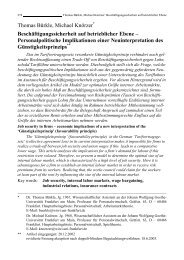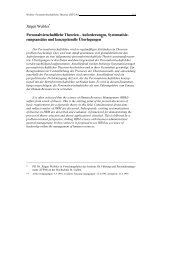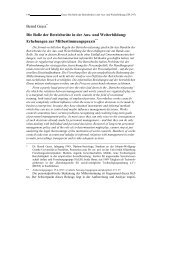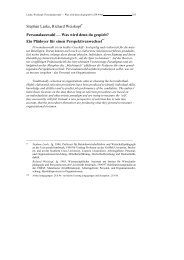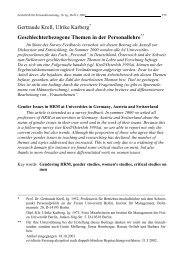Personalforschung an Hochschulen - Rainer Hampp Verlag
Personalforschung an Hochschulen - Rainer Hampp Verlag
Personalforschung an Hochschulen - Rainer Hampp Verlag
Erfolgreiche ePaper selbst erstellen
Machen Sie aus Ihren PDF Publikationen ein blätterbares Flipbook mit unserer einzigartigen Google optimierten e-Paper Software.
Zeitschrift für <strong>Personalforschung</strong>, 17. Jg., Heft 4, 2003 447<br />
This finding is rather unspectacular, because intuitively it seems to be reasonable<br />
that workers’ wages are a function of the time spend in the labor market <strong>an</strong>d in<br />
particular of the length devoted with one <strong>an</strong>d the same employer. While this positive<br />
correlation is a commonly accepted result, a lot of controversial talk over the interpretation<br />
of the noticed association between earnings <strong>an</strong>d tenure has grown up over the<br />
past two decades, as the authors derived their findings from very different assumptions.<br />
Even years before the emergence of the two rival theories, Mincer (1974) questioned<br />
the hum<strong>an</strong> capital model, if <strong>an</strong> empirical test would fail to show that wage<br />
growth correlates with productivity progress. The first of the countless studies which<br />
were to follow on that attempted to <strong>an</strong>swer the question whether wages actually increase<br />
with productivity via tenure was Medoff/Abraham (1980,1981) who concluded<br />
that the hum<strong>an</strong> capital theory might not be adequate in explaining the upward-sloping<br />
age-earnings profile but instead the Lazear style model is more appropriate.<br />
Over time, progress has been made concerning the debate which researcher’s<br />
theory (or combination of theories) provides the best expl<strong>an</strong>ation for the positive<br />
wage-tenure relationship. In the mid 80’s Jov<strong>an</strong>ovic’s matching model was favored<br />
while the other two alternatives were discredited. Two very influential papers, Abraham/Farber<br />
(1987) <strong>an</strong>d Altonji/Shakotko (1987) concluded that wages slope upwards<br />
due to unobserved individual <strong>an</strong>d match heterogeneity <strong>an</strong>d not due to job seniority. In<br />
a subsequent work, Topel (1991) disproved these results <strong>an</strong>d argued that when the<br />
formers’ econometric problems were solved for, findings were supportive of the hum<strong>an</strong><br />
capital pattern. Altonji/Williams (1997) stroke back, reexamining <strong>an</strong>d defending<br />
the Altonji/Shakotko findings from 1987.<br />
To date, there is still <strong>an</strong> ongoing empirical dispute, seeking to clarify the relationship<br />
between wages <strong>an</strong>d tenure. Indeed, as noted by Felli/Harris (1996), this debate<br />
remains <strong>an</strong> open question in the empirical <strong>an</strong>alysis of labor markets. While even<br />
the latest bulk of empirical work has tested whether or not one particular theory c<strong>an</strong><br />
indeed explain the upward-sloping age-earnings profile (see Neumark/Taubm<strong>an</strong><br />
(1995) <strong>an</strong>d Azfar/D<strong>an</strong>ninger (2001)) studies that aimed to discriminate between all<br />
three competing hypotheses has not been conducted yet. In this respect, previous empirical<br />
evidence is suggestive but inconclusive, because of the difficulties in measuring<br />
precisely <strong>an</strong>d objectively individual worker productivity.<br />
The principal objective of this paper is to pave the road in order to gain a full<br />
underst<strong>an</strong>ding of the question which one theory provides the best expl<strong>an</strong>ation why<br />
wages increase with seniority. The fact, that empirical studies have not yet tackled the<br />
obvious question of checking all three major theories versus each other using data<br />
from one single industry with homogenous job characteristics is somewhat surprising.<br />
Due to this deficit, I believe that there is considerable room for improvement. Consequently,<br />
it’s time to breath new life into the puzzle that emerged more th<strong>an</strong> 20 years<br />
ago.



